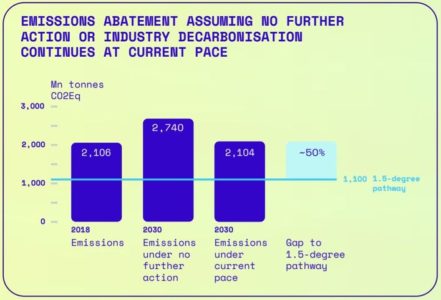Since Adam and Eve bit the apple, we’ve been burdened with the need for clothing whenever we walk outside. More than a necessity, it’s become a means of expression, a statement, and the vehicle of many trends. However, overconsumption has led to the rise of fast fashion, a wasteful and polluting system that our environment bears the cost of, while its emissions accelerate climate change.
Earth.Org takes a closer look; so check their review.
***
In the past 20 years, clothing production has approximately doubled due to higher demand from a growing middle class worldwide. Meanwhile, garment usage lifetime has decreased on the consumer side. This embodies the “fast fashion” phenomenon: more options, quicker trend turnaround, lower prices, and unpriced damage to the environment.

Most shocking in the graph above is the decrease in clothing utilization: 36% globally. China saw a whopping 70% decrease over the same period, and 60% of German and Chinese citizens admit to owning more clothes than they need. The picture varies from location to location, with Europeans usually spending more on fewer items each year, while Americans or Chinese buy far more pieces per person.

Fast Fashion and the Environment
The industry is representative of consumerism, creating a need and producing excessively. Moreover, our clothing production, distribution and disposal system is horrendously wasteful and polluting. According to McKinsey, the textile industry (60% of which goes into clothing) pumped 2.1 billion metric tons of greenhouse gases into the atmosphere in 2018, accounting for 4% of global emissions that year. For context, that is much as the economies of France, Germany and the United Kingdom combined.
The fashion industry itself consumes an estimated 93 billion cubic metres of water each year, much of which ends up contaminated by toxic chemicals. According to the UN Environment Programme, 20% of global wastewater comes from textile dyeing. Because the bulk of these operations are in countries with less regulation, the wastewater often finds its way to the ocean where it can wreak havoc.

Industrial wastewater containing hazardous chemicals discharged into the Cihaur River, a tributary of the Citarum River. Source: Greenpeace.
In this age of fast fashion, we discard around 92 million tons of clothes-related waste each year. In other words, a garbage truck full of clothes is either incinerated or sent to the landfill every second, enough to fill one and a half Empire State Buildings every day.
Before they’re even thrown out, our synthetic garments produce serious amounts of pollution by shedding microfilaments in the wash or drying machine. Around 50% of our clothing is made from plastic, and they produce half a million tons of microplastics that make their way into the ocean every year.
Ironically, these absorb the toxic chemicals we let leak, then work their way up the food chain back to us.
The current system is simply unsustainable due to its high volume, yet linear nature. Massive amounts of resources are extracted, processed, used only briefly, then thrown out.

Less than 1% of the material used to make clothes is recycled into new clothing, meaning over USD 100 billion worth of material is lost each year. We are missing out on opportunities to reuse, recycle and even profit from a more circular system.
Fast Fashion’s Societal Impacts
Beyond fast fashion ‘s effect on the environment are the deplorable conditions people work in to satisfy the ever-soaring demand.
According to non-profit Remake, 75 million people are making our clothes this very day, 80% of which are young women between 18 and 24.
The Bangladeshi female garment workers make about $96 per month according to The Fashion Law. That’s 3.5 times less than is needed to live a “decent life with basic facilities”, based on the Bangladeshi government’s wage board statistics.
Worse yet, forced child labor is very real, and ongoing in Argentina, Bangladesh, Brazil, China, India, Indonesia, Philippines, Turkey, Vietnam and other countries.
You can find out where and how your favorite brands make their products anytime. It could be worth it.
Fast Fashion and Climate Change
As mentioned before, it emitted 2.1 billion metric tons of CO2 equivalent (CO2e) greenhouse gases in 2018, which is highly incompatible with the 1.5°C pathway targeted by the Paris Agreement. If no action is taken, its yearly emissions are expected to surpass 2.74 billion tons by 2030, but if mitigation continues at its current pace, emissions will stay where they are. According to McKinsey’s “Fashion on Climate” report, a 50% reduction is necessary to meet the 1.5°C pathway.

Source: Fashion on Climate, McKinsey (2020).
The report explains that such a reduction is in fact feasible, but first, let’s break down the industry’s emission sources.

Source: Fashion on Climate, McKinsey (2020).
The bulk of emissions come from material production and processing, while a little over 20% comes from the consumer side, and 6% from transport and retail.
In order to comply with the 1.5°C pathway, McKinsey’s report proposes the following:
Reducing emissions from upstream operations
This essentially consists of replacing all upstream energy sources with renewable-generated electric power. This alone covers 63% of the emission reduction needed.
Reducing emissions from brands operations
The key lever here is reducing oversupplying shops, often leading to markdowns or disposals. Technology investment for producing better forecasts and stock management would deliver.
Encouraging sustainable consumer behaviours
This one concerns more of us so I will go into further detail. Circular business models, like fashion rentals, re-commerce, repair and refurbishment (think thrift stores) are essential to a sustainable fashion industry. Reduced washing and drying is also important. Consider: by skipping one in six washing loads, washing half loads at below 30 degrees, and substituting every sixth dryer uwsage with open-air drying, we would reduce consumer emissions by more than half.
The rise of renewables makes clean energy transitions in large industries quite likely, though it remains to be seen how fast it happens. For the appropriate infrastructures to reach production regions might take some time, and their governments are behind on incentivizing renewables. As for brands, their operations might benefit from the democratization of machine learning applications that can be very powerful for forecasting demand and the like.
Beyond this, it is incredibly empowering to know that much of the onus falls on us as individuals, and that our actions can indeed make a difference. By making the right decisions and educating those around us, we can reverse the trend of fast fashion and relieve the pressure it puts on the environment.



